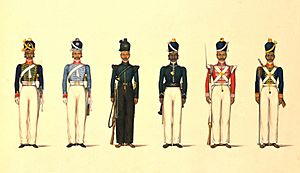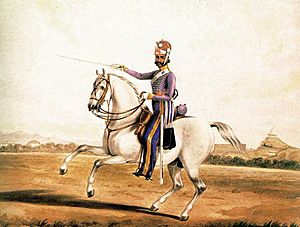Madras Army facts for kids
Quick facts for kids Madras Army |
|
|---|---|
 |
|
| Active | 1757–1895 (as the Madras Army) 1895–1908 (as the Madras Command of the Indian Army) |
| Branch | Presidency armies |
| Type | Command |
| Size | 47,000 (1876) |
| Garrison/HQ | Ootacamund, Nilgiris district |
The Madras Army was a military force in British India. It belonged to the Presidency of Madras, which was one of the three main regions controlled by the British. These armies were first part of the East India Company. This company was a powerful British trading business. Later, after the Indian Rebellion of 1857, the armies came under the direct control of the British Crown.
In 1895, the three presidency armies, including the Madras Army, joined together. They became part of the larger Indian Army.
Contents
How the Madras Army Started
The Madras Army began because the East India Company needed to protect its trade. At first, they only had guards who were not well trained. But when the French attacked and captured Madras in 1746, the British realized they needed a stronger army.
So, in 1757, the East India Company decided to create proper military units. These units were trained to fight, take over land, and make local rulers loyal to the British.
At first, the army units were not very organized. But they were soon put into larger groups called battalions. Indian officers led the local soldiers. One of their first big battles was the battle of Wandiwash in 1760. The soldiers were praised for being brave and steady during the fight. Before this, some soldiers from Madras were sent to Bengal. They fought under a young officer named Clive. He became famous after the Battle of Plassey.
In the early days, British officers in the Madras Army respected the local customs of their soldiers. They paid attention to their caste, traditions, and how they dressed. Some important local landowners even joined the army. But as the army grew, new officers came in. Many of these new leaders did not care as much about the soldiers' traditions. This led to problems.
One famous event was the Vellore mutiny. After Tipu Sultan was killed, his two sons were kept by the British in Vellore Fort. On July 10, 1806, soldiers from three Madras regiments in the fort rebelled. They killed 129 British officers and soldiers. The rebellion was caused by a mix of military rules and political anger. However, it was quickly stopped by loyal Madras cavalry troops.
In the 1830s, the Madras Army mainly kept peace and helped the government. This army had soldiers from many different backgrounds. British officers were encouraged to learn and speak local languages. In 1832–33, the Madras Army used its good training to stop a rebellion in the Visakhapatnam district.
Under British Rule
After the 1857 Rebellion
The Madras Army was mostly not affected by the Indian Rebellion of 1857. This was very different from the larger Bengal Army. In the Bengal Army, almost all regiments either rebelled or were shut down. But all 52 regiments of the Madras Native Infantry stayed loyal. They then became part of the new Indian Army when the British Crown took direct control. However, some Madras Light Cavalry and Artillery units were removed after 1858.
The End of the Separate Madras Army
In 1895, the three separate Presidency Armies started to combine. This process finished eight years later. As a first step, the Army of India was divided into four main commands. These included Madras (which also covered Burma), Punjab, Bengal, and Bombay. By 1903, the regiments from Madras, Bombay, and Bengal were all put into one system. They were no longer known by their old presidency names.
Madras Infantry Regiments Disbanded
Even though the Madras Army existed until 1895, many of its infantry regiments were slowly shut down. Twelve regiments were disbanded between 1862 and 1864. More were disbanded in the following years. By 1933, most of the Madras infantry regiments were gone. Only the respected Madras Sappers and Miners remained as a Madras unit in the Indian Army. However, a new Madras Regiment was created in 1942 during World War II. Both of these regiments still exist today in the modern Indian Army.
Some British generals, like Sir Frederick Roberts, believed that soldiers from Southern India were not as good as those from the North. He thought long periods of peace in the South made them less effective. He preferred soldiers from groups he called "Martial Races" like Sikhs and Rajputs.
However, historians have pointed out that Madras regiments rarely got to fight on the North-West Frontier. This was because of the way the Presidency Armies were organized. So, ambitious British officers chose to serve with northern units instead. This meant the overall quality of the Madras Army suffered.
What the Madras Army Was Made Of
The Madras Army had different types of units:
Madras Native Infantry
These were infantry (foot soldier) regiments made up of Indian soldiers. Some examples include:
- 1st Regiment of Madras Native Infantry
- 2nd Regiment of Madras Native Infantry
- 3rd Regiment of Madras Native Infantry Palamcottah Light Infantry
- 4th Regiment of Madras Native Infantry
- 5th Regiment of Madras Native Infantry
- 6th Regiment of Madras Native Infantry
- 7th Regiment of Madras Native Infantry
- 8th Regiment of Madras Native Infantry
- 9th Regiment of Madras Native Infantry
- 10th Regiment of Madras Native Infantry
- 11th Regiment of Madras Native Infantry
- 12th Regiment of Madras Native Infantry
- 13th Regiment of Madras Native Infantry
- 14th Regiment of Madras Native Infantry
- 16th Regiment of Madras Native Infantry
- 17th Regiment of Madras Native Infantry
- 18th Regiment of Madras Native Infantry
- 19th Regiment of Madras Native Infantry
- 20th Regiment of Madras Native Infantry
- 21st Regiment of Madras Native Infantry
- 22nd Regiment of Madras Native Infantry
- 23rd Regiment of Madras Native Infantry Wallajahbad Light infantry
- 24th Regiment of Madras Native Infantry
- 25th Regiment of Madras Native Infantry
- 26th Regiment of Madras Native Infantry
- 27th Regiment of Madras Native Infantry
- 28th Regiment of Madras Native Infantry
- 29th Regiment of Madras Native Infantry
- 30th Regiment of Madras Native Infantry
- 31st Regiment of Madras Native Infantry Trichinopoly Light Infantry
- 32nd Regiment of Madras Native Infantry
- 33rd Regiment of Madras Native Infantry
- 34th Regiment of Madras Native Infantry Chicacole Light Infantry
- 35th Regiment of Madras Native Infantry
- 36th Regiment of Madras Native Infantry
- 37th Regiment of Madras Native Infantry
- 38th Regiment of Madras Native Infantry
- 39th Regiment of Madras Native Infantry
- 40th Regiment of Madras Native Infantry
- 41st Regiment of Madras Native Infantry
- 42nd Regiment of Madras Native Infantry
- 43rd Regiment of Madras Native Infantry
- 44th Regiment of Madras Native Infantry
- 45th Regiment of Madras Native Infantry
- 46th Regiment of Madras Native Infantry
- 47th Regiment of Madras Native Infantry
- 48th Regiment of Madras Native Infantry
- 49th Regiment of Madras Native Infantry
- 50th Regiment of Madras Native Infantry
- Madras Rifle Corps
Madras European Infantry
These were infantry regiments made up of European soldiers.
- 1st Madras (European) Fusiliers
- 2nd Madras (European) Light Infantry
- 3rd Madras (European) Infantry
Madras Light Cavalry
These were cavalry (horseback soldier) regiments.
- 1st Madras Light Cavalry
- 2nd Madras Light Cavalry
- 3rd Madras Light Cavalry
- 4th Madras Light Cavalry
- 5th Madras Light Cavalry
- 6th Madras Light Cavalry
- 7th Madras Light Cavalry
- 8th Madras Light Cavalry
Artillery
The Artillery units used cannons and other big guns. This included the Madras Foot Artillery and the Madras Horse Artillery.
Engineers
The Engineers were specialized units. They built things like bridges and forts, and also destroyed enemy defenses.
- Corps of Madras Sappers and Miners
See also
Sources





